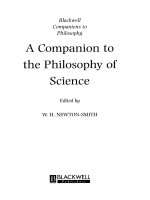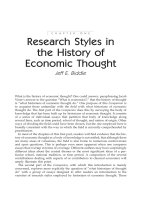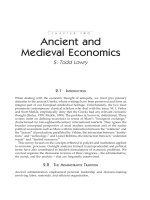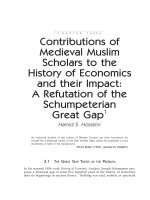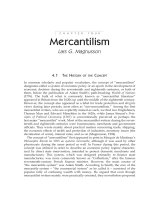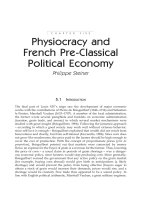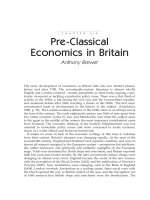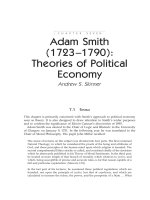A companion to clare of assisi
Bạn đang xem bản rút gọn của tài liệu. Xem và tải ngay bản đầy đủ của tài liệu tại đây (1.71 MB, 329 trang )
A Companion to Clare of Assisi
Brill’s Companions
to the
Christian Tradition
A series of handbooks and reference works
on the intellectual and religious life of Europe,
500–1700
VOLUME 21
A Companion to Clare of Assisi
Life, Writings, and Spirituality
By
Joan Mueller
LEIDEN • BOSTON
2010
On the cover: Tavola of Clare (Courtesy of Tau-AV Produktion, photo by Bruno Fäh).
A thirteenth-century iconic altarpiece depicting eight scenes from the life of Clare.
This book is printed on acid-free paper.
The copyright of translations of primary source material remains the property of the
author.
Library of Congress Cataloging-in-Publication Data
Mueller, Joan, 1956–
A companion to Clare of Assisi : life, writings, and spirituality / by Joan Mueller.
p. cm.—(Brill’s companions to the Christian tradition ; v. 21)
Includes bibliographical references and index.
ISBN 978-90-04-18216-5 (hardback : alk. paper)
1. Clare, of Assisi, Saint, 1194–1253. I. Title. II. Series.
BX4700.C6M85 2010
271’.97302—dc22
2010003651
ISSN 1871-6377
ISBN 978 90 04 18216 5
Copyright 2010 by Koninklijke Brill NV, Leiden, The Netherlands.
Koninklijke Brill NV incorporates the imprints Brill, Hotei Publishing,
IDC Publishers, Martinus Nijhoff Publishers and VSP.
All rights reserved. No part of this publication may be reproduced, translated,
stored in a retrieval system, or transmitted in any form or by any means, electronic,
mechanical, photocopying, recording or otherwise, without prior written permission
from the publisher.
Authorization to photocopy items for internal or personal use is granted
by Koninklijke Brill NV provided that the appropriate fees are paid directly to
The Copyright Clearance Center, 222 Rosewood Drive, Suite 910,
Danvers, MA 01923, USA.
Fees are subject to change.
printed in the netherlands
To Mother Mary Regina, PCC
With Gratitude
CONTENTS
List of Illustrations .............................................................................
Abbreviations ......................................................................................
ix
xi
Introduction ........................................................................................
1
PART I
CLARE: FRANCISCAN WOMEN
Chapter One The Franciscan Choice ...........................................
Chapter Two The Monastery of S. Damiano ...............................
Chapter Three The Politics of “Infant’s Milk”: Clare of Assisi
and the Privilege of Poverty ..........................................................
Chapter Four The Ordo that Gregory IX Founded: Clare
among other Ugolinian Sisters .....................................................
11
35
65
91
PART II
CLARE: HER WRITINGS
Chapter Five Reading Clare’s Letters in Context ........................
Chapter Six The Agnes Legend in Clare’s Letters..........................
Appendix: The Legend of S. Agnes of Rome .................................
Chapter Seven Clare’s Forma Vitae: Unique Contributions ........
119
169
199
209
PART III
CLARE: HER WRITINGS IN TRANSLATION
Clare’s First Letter to Agnes ..............................................................
Clare’s Second Letter to Agnes .........................................................
Clare’s Third Letter to Agnes ............................................................
Clare’s Fourth Letter to Agnes ..........................................................
Clare’s Forma Vitae .............................................................................
261
265
267
271
275
viii
contents
Bibliography ........................................................................................
Index ....................................................................................................
287
301
Illustrations .........................................................................................
309
LIST OF ILLUSTRATIONS
1. Tavola of Clare (Courtesy of Tau-AV Produktion, photo by
Bruno Fäh).
A thirteenth-century iconic altarpiece depicting eight scenes
from the life of Clare .....................................................................
2. Scene from the Tavola of Clare (Courtesy of Tau-AV
Produktion, photo by Bruno Fäh).
This scene depicts Catherine joining Clare at S. Angelo
di Panzo ..........................................................................................
3. S. Damiano in Assisi—the front of the monastery (Courtesy of
Daren Zehnle).
This church repaired by Francis became the monastery of
Clare and her sisters ......................................................................
4. S. Damiano in Assisi—the garden (Courtesy of Daren Zehnle) ...
5. The Privilege of Poverty (Courtesy of the Protomonastery of
S. Chiara in Assisi, Italy).
The official 1228 letter from Gregory IX giving the S. Damiano
sisters the privilege not to be forced to own property ..............
6. Agnes of Prague in Wenceslas Square (Photo by Joan Mueller).
This image of Agnes of Prague is sculpted among Prague’s
patron saints in Wenceslas Square, the site of the November,
1989, Velvet Revolution, that led to the collapse of the
communist regime ........................................................................
7. Agnes of Prague and Agnes of Assisi (Courtesy of Národní
Knihovna České Republiky in Prague).
Miniature of Agnes of Prague (circa 1270; Osek Lectionary,
fol. 160r) addressing her namesake, the virgin martyr,
Agnes of Rome, who is holding the palm of martyrdom ........
8. Agnes of Prague’s Funerary Monument (Photo by Joan Mueller).
Agnes’s limestone funerary monument located in the south
wall of the Chapel of the Virgin Mary—one of a network of
churches and chapels incorporated into Agnes’s monastery
in Prague. The nuns, concerned with the periodic flooding
of the monastery and wishing to protect Agnes’s remains,
exhumed her body and placed it in a wooden coffin.
Unfortunately, these remains were lost in the 1420 Hussite
revolution .......................................................................................
310
311
312
312
313
314
315
316
ABBREVIATIONS
Clare and Agnes Sources
1LAg
2LAg
3LAg
4LAg
FLUg
FLInn
FLCl
LegCl
LegAg
Process
Clare’s First Letter to Agnes of Prague
Clare’s Second Letter to Agnes of Prague
Clare’s Third Letter to Agnes of Prague
Clare’s Fourth Letter to Agnes of Prague
Gregory IX’s Form of Life
Innocent IV’s Form of Life
Clare’s Form of Life
The Legend of Clare of Assisi
The Legend of Agnes of Prague
Acts of the Process of Canonization of Clare
Francis Sources
1C
2C
1LtF
2LtF
AC
ChrJG
ER
LR
L3C
ScEx
Testament
The Life of Francis by Thomas of Celano
The Remembrance of the Desire of a Soul
The First Letter to the Faithful
The Second Letter to the Faithful
The Assisi Compilation
The Chronicle of Jordan of Giano
The 1221 Rule of the Friars Minor (Regula non bullata)
The 1223 Rule of the Friars Minor (Regula bullata)
The Legend of the Three Companions
The Sacred Exchange between Francis and Lady Poverty
The Testament of S. Francis
Standard Works and Periodicals
AF
AFH
AASS
BF
CDB
Analecta Franciscana
Archivum Franciscanum Historicum
Acta Sanctorum
Bullarium Franciscanum
Codex Diplomaticus et Epistolaris Regni Bohemiae
xii
abbreviations
CF
FF
FranzStud
FRB
FS
Latham
Collectanea Franciscana
Fontes Franciscani
Franziskanische Studien
Fontes Rerum Bohemicarum
Franciscan Studies
Revised Medieval Latin Word-List from British and Irish
Sources (London 1965)
LTK
Lexikon für Theologie und Kirche
MF
Miscellanea Francescana
MGH
Monumenta Germaniae historica
MGH SS
Monumenta Germaniae historica, Scriptores
Niermeyer Mediae Latinitatis Lexicon Minus
OLD
Oxford Latin Dictionary
PL
Patrologia Latina
SF
C. D. Lanham, “Salutatio” Formulas in Latin Letters to
1200: Syntax, Style, and Theory (Munich 1975)
Souter
A. Souter, A Glossary of Later Latin to 600 A.D. (Oxford
1949)
ST
Studi e Testi
Scripture abbreviations in Latin texts referring to books of the Vulgate Bible are taken from Biblia sacra iuxta Vulgatam versionem, ed.
R. Gryson et al., 4th rev. ed. (Stuttgart 1994).
INTRODUCTION
The life of Clare of Assisi and her monastery of sisters at S. Damiano
in Assisi is pivotal to the history of the Franciscan movement. Clare
accompanied Francis from the beginning of his ministry and survived
him by more than twenty-five years. During this time, she persisted in
the face of a deposition of a minister general who she greatly respected,
tightening canonical legislation not always sympathetic to her wishes
to follow the Poor Christ, and creeping clericalism within the Franciscan Order. All these challenges Clare faced with joy and courage,
determined to follow the path that Francis had taught her.
Building on the contribution of archival and paleographical work
done by dedicated friars in the early twentieth century, the bulk of
today’s study of Clare is done by medievalists all over the world and
in a variety of settings. In the later third of the twentieth century, collections and translations of the Clare corpus built upon and continued
the archival work.1 Refining the broad strokes of Herbert Grundmann,
who situated Franciscan women within the context of the twelfth and
thirteenth century “women’s movement,”2 contemporary Clare scholars focus their attention on the “women’s movement” on the late
1
Ignacio Omaechevarria, ed., Escritos de Santa Clara y documentos contemporaneous (Madrid: Biblioteca de Autores Cristianos 1970; 1982); Engelbert Grau, ed., Leben
und Schriften der hl. Klara (Werl/Westf: D.-Coelde-Verlag, 1953); Giovanni Boccali,
ed., Opuscula S. Francisci et scripta S. Clarae Assisiensium (Assisi: Edizione Porziuncola, 1978); Marie-France Becker, Jean-François Godet and Thaddée Matura, eds.,
Claire d’Assise: Écrits (Paris: Editions du Cerf, 1985); Regis Armstrong, trans., Clare
of Assisi: Early Documents (New York: New City Press, 2006).
2
On the thirteenth-century women’s movement see Herbert Grundmann, Religiöse
Bewegungen im Mittelalter: Untersuchungen über die geschichtlichen Zusammenhänge
zwischen der Ketzerei, den Bettelorden und der religiösen Frauenbewegung im 12.
und 13. Jahrhundert, und über die geschichtlichen Grundlagen der deutschen Mystik
(Hildesheim: G. Olms, 1961), in English as Religious Movements in the Middle Ages,
trans. Steven Rowan (Notre Dame, IN: University of Notre Dame Press, 1995); Jacques
Leclercq, “Il monachesimo femminile nei secoli XII e XIII,” in Movimento religioso
femminile e francescanesimo nel secolo XIII, ed. Roberto Rusconi, 61–99 (Assisi: Società internazionale di studi francescani, 1980); Edith Pasztor, Donne e santé: Studi sulla
religiosità femminile nel medio evo (Rome: Edizioni Studium, 2000); Brenda Bolton,
“Mulieres Sanctae,” in Sanctity and Secularity: The Church and the World, ed. Derek
Baker, 77–95 (Oxford: B. Blackwell, 1973).
2
introduction
medieval Italian peninsula3 as well as other Italian manifestations of
medieval, feminine piety.4
More specific studies on Clare’s life and writings have followed,
most recently a monumental multivolume work on Clare’s forma vitae
by the Federazione S. Chiara di Assisi.5 Marco Bartoli’s bibliographic
study of Clare remains a critical text.6 Building on the work of Livarius
Oliger7 and Lilly Zarncke,8 Maria Pia Alberzoni has specialized in writing the legislative history of Clare’s monastery in relationship to the
thirteenth-century papacy.9 My own work has been a literary study of
3
Among many possible studies, see for example, Marco Bartoli, “La povertà e il
movimento francescano femminile,” in Dalla ‘sequela Christi’ di Francesco d’Assisi
all’apologia della povertà, ed. Enrico Menestò, 223–48 (Spoleto: Centro italiano di
studi sull’alto medioevo, 1992); Robert Brentano, “Il movimento religioso femminile
a Rieti nei secoli XIII–XIV,” in Il movimento religioso femminile in Umbria dei secoli
XIII–XIV, ed. Roberto Rusconi, 67–83 (Spoleto: Centro italiano di studi sull’alto
medioevo, 1991); Giovanna Casagrande “Forme di vita religiosa femminile nell’area
di Città di Castello nel secolo XIII,” in Il movimento religioso femminile in Umbria dei
secoli XIII–XIV, ed. Roberto Rusconi, 123–57 (Perugia: Regione dell’Umbria, 1984);
Peter Höhler, “Il monastero delle Clarisse di Monteluce in Perugia (1218–1400),” in
Il movimento religioso femminile in Umbria dei secoli XIII–XIV, ed. Roberto Rusconi,
159–82 (Perugia: Regione dell’Umbria, 1984); and Daniel Bornstein, “Women and
Religion in Late Medieval Italy: History and Historiography,” in Women and Religion
in Medieval and Renaissance Italy, ed. Daniel Bornstein and Roberto Rusconi, 1–27
(Chicago: The University of Chicago Press, 1996).
4
Anna Benvenuti Papi, In castro poenitentiae: Santità e società femminile nell’Italia
medievale (Rome: Herder, 1990); Mario Sensi, Storie di bizzoche tra Umbria e Marche
(Rome: Edizioni di storia e letteratura, 1995); Mario Sensi, “Incarcerate e recluse in
Umbria nei secoli XIII e XIV: Un bizzocaggio centro-italiano,” in Il movimento religioso femminile in Umbria dei secoli XIII–XIV, ed. Roberto Rusconi, 85–121 (Florence:
La Nuova Italia, 1984).
5
Chiara di Assisi e le sue fonti legislative: Sinossi cromatica (Padua: Edizioni Messaggero, 2003); Chiara di Assisi: Una vita prende forma: Iter storico (Padua: Edizioni
Messaggero, 2005); and Il Vangelo come forma di vita: In ascolto di Chiara nella sua
Regola. (Padua: Edizioni Messaggero, 2007).
6
Chiara d’Assisi (Rome: Istituto storico dei Cappuccini, 1989).
7
“De origine regularum ordinis S. Clarae,” AFH 5 (1912): 181–209; 413–47.
8
Der Anteil des Kardinals Ugolino an der Ausbildung der drei Orden des Heiligen
Franz (Hildesheim: Gerstenberg, 1972, [1930]).
9
Chiara e il papato (Milan: Edizioni Biblioteca Francescana, 1995); La nascita di
un’istituzione: L’ordine di S. Damiano nel XIII secolo (Milan: Edizioni CUSL, 1996);
“Nequaquam a Christi sequela in perpetuum absolvi desidero: Chiara tra carisma e
istituzione,” in Chiara d’Assisi e la memoria de Francesco, ed. Alfonso Marini and
Maria Beatrice Mistretta, 41–65 (Città di Castello: Petruzzi, 1995); “San Damiano nel
1228: Contributo alla questione clariana,” CF 67 (1997): 459–76; “Curia romana e
regolamentazione delle Damianite e delle Domenicane,” in Regulae, consuetudines,
statuta: Studi sulle fonti normative degli ordini religiosi nei secoli centrali del medioevo,
ed. Cristina Andenna and Gert Melville, 501–37 (Münster: Lit Verlag, 2005); Clare of
introduction
3
Clare’s letters,10 while Jaroslav Polc,11 Alfonso Marini,12 and ChristianFrederik Felskau’s13 studies have focused on Clare’s dialogue partner,
Agnes of Prague. Other scholars such as Sean Field,14 Lezlie Knox,15
and Jeryldene Wood16 are moving the research further into the years
after Clare’s death. Although there is currently a flurry of scholarly
work, much of which is presently in process or in press, regarding laywomen who were more or less associated with the Franciscan friars,
this broader 13th century Franciscan “women’s movement” is not the
focus of this volume and deserves to be studied in its own right.
It is the hope of this volume to dialogue with the hundreds of articles and books in the field in order to present the current state of
studies concerning Clare of Assisi. While the chapters of this text progressively deal with differing aspects of the Clare story, each chapter
is written to stand by itself.
The book is organized into three parts. Part I, chapters 1–4, deals
with Clare as a Franciscan woman and describes her early life, conversion, manner of living within the S. Damiano monastery, her struggle
to obtain the “privilege of poverty,” and her unique contribution to
the history of monasticism. Part II, chapters 5–7, examines Clare’s
writings, in particular her four letters to Agnes of Prague, her literary
Assisi and the Poor Sisters in the Thirteenth Century, ed. Jean-François Godet-Calogeras (St. Bonaventure: The Franciscan Institute, 2004).
10
Joan Mueller, Clare’s Letters to Agnes: Texts and Sources (St. Bonaventure, NY:
The Franciscan Institute, 2001); Clare of Assisi: The Letters to Agnes (Collegeville, MN:
Liturgical Press, 2003), and “Clare of Assisi and the Agnes Legend: A Franciscan Citing
of St. Agnes of Rome as Mulier Sancta,” Studies in Spirituality 8 (1998): 141–61.
11
Jaroslav Polc, Agnes von Böhmen 1211–1282: Königstochter—Äbtissin—Heilige
(München: R. Oldenbourg Verlag, 1989).
12
Agnese di Boemia (Rome: Istituto storico dei Cappuccini, 1991); “Pauperem
Christum, virgo pauper, amplectere: Il punto su Chiara ed Agnese di Boemia,” in Chiara e la diffusione delle Clarisse nel secolo XIII, ed. Giancarlo Andenna and Benedetto
Vetere, 121–32 (Galatina: Congedo, 1998).
13
Agnes von Böhmen und die Klosteranlage der Klarissen und Franziskaner in Prag:
Leben und Institution, Legende und Verehrung (Nordhausen: Bautz, 2008); and “Hoc
est quod cupio: Approaching the Religious Goals of Clare of Assisi, Agnes of Bohemia,
and Isabelle of France,” Magistra 12 (2006): 3–28.
14
Isabelle of France: Capetian Sanctity and Franciscan Identity in the Thirteenth
Century (Notre Dame, IN: University of Notre Dame Press, 2006).
15
Creating Clare of Assisi: Female Franciscan Identities in Later Medieval Italy
(Leiden: Brill, 2008); and “One and the Same Spirit: Clare of Assisi’s Form of Life in
the Later Middle Ages,” FS 64 (2006): 235–54.
16
Women, Art, and Spirituality: The Poor Clares of Early Modern Italy (Cambridge:
Cambridge University Press, 1996).
4
introduction
use of the Legend of S. Agnes of Rome in these letters, and her forma
vitae. Part III consists of Clare’s writings, in particular her letters to
Agnes of Prague and her forma vitae, in translation.
Chapter one begins with a description of the context of Clare’s
Franciscan choice as a woman of the thirteenth-century Italian peninsula. It continues with a description of the sources for Clare’s life
and writings, and proposes a methodology. The text then utilizes this
methodology to document Clare’s early life, including her life before
meeting Francis, her conversations with Francis, her conversion and
tonsure at S. Maria degli Angeli, her subsequent stay at S. Paolo delle
Abbadesse and S. Angelo di Panzo, and the conversion of her blood
sister Catherine, who Francis latter renamed Agnes.
Using the witness of the S. Damiano sisters in Clare’s canonization
process and pertinent material from the Legend of Clare, chapter two
describes daily life within the S. Damiano monastery during Clare’s
tenure as abbess. Its goal is to organize the above source material
around themes that permit the reader to imagine the life of Clare and
her sisters. Before one can say anything about Clare’s prayer, her presence among her sisters, her dedication to the “privilege of poverty,”
or her relationship with her Franciscan brothers, this organization of
source material is necessary.
The third chapter studies the charismatic context of Clare’s “privilege of poverty” vis-à-vis the legislative goals of the thirteenth-century
papacy. It uses the jargonized reference to “infants’ milk” to trace
Clare’s struggle to keep her cherished “privilege,” while introducing
the contribution of Agnes of Prague in this struggle. The medieval
politics that complicated Clare’s Franciscan existence are still being
mined by contemporary scholars, and studies on this topic continue
to proliferate and expand current understanding of Clare.
Chapter four represents a type of study that is both old and in its
infancy. Old, in that searching monastic and communal archives for
manuscripts concerning Ugolinian nuns has a long and complex history; new, because making sense of and organizing these local documents is still very much a work in progress. To this end, four Ugolinian
monasteries are presented in this chapter that either did not persevere
in the “privilege of poverty” or never requested it. It is intended that
such an examination will provide readers with a foil that reflects what
Clare was refusing in her struggle with the papacy.
introduction
5
While chapters one through four deal with aspects of Clare’s life
and milieu, Part II of the text, chapters five through seven, concerns
her written legacy. Chapter five contains historical background and
commentary on Clare’s four letters to Agnes of Prague. These letters
are not merely spiritual letters, but historical letters. Reading them in
historical context gives the reader a sense of what Clare is referring to
as well as a clearer sense of her spirituality.
Chapter six concerns a critical text found within Clare’s letters, the
Legend of S. Agnes of Rome. Writing to Agnes of Prague, who she had
never and would never meet, Clare needed a logical connection. The
Legend of S. Agnes of Rome was known by women throughout the
medieval world, often in the vernacular. It surely would be familiar to
one whose name was Agnes. Because Clare used this text brilliantly
throughout her letters, not appreciating her savvy in improvising on
this text would make for an uncontextualized reading. This chapter,
therefore, presents points of contact between Clare’s text and the
Roman Legend. It is followed by an English translation of the entire
Legend of S. Agnes of Rome by my colleague Julia Fleming, Ph.D., so
that readers might study the relationships found within the various
texts.
Chapter seven is a chapter-by-chapter commentary on Clare’s forma
vitae. It includes documentation regarding secondary literature that
discusses various topics found within Clare’s forma vitae, as well as
references to Clare’s dependence on other legislative texts and Franciscan hagiographical literature.
Part III consists of my translations of Clare’s four letters to Agnes of
Prague as well my translation of Clare’s forma vitae so that the reader
can easily refer to these translations while working through the various
chapter commentaries. Notes for these translations are found within
the commentaries of chapters five-seven.
Many colleagues were involved in the research and writing of this
manuscript. As one can tell by the footnotes, scholarly work on Clare
of Assisi is a fruitful field and I am indebted to authors in English, Italian, French, German, Czech, Spanish, and Catalan for their insights.
Helpful for the resolution of various language issues were Dr. Andreas
Gommermann, Dr. Frank Mantello, Yvonne Reher, Dolorosa Kremlacek, ND, Suzanne Noffke, OP, Ludmila Pospíšilová, OSF, Richard
McGloin, S.J., Dr. Thomas Coffey, Dr. Geoffrey Bakewell, Reginald
Foster, OCD, Dr. Maria Teresa Vanderboegh, Dr. Jean François
6
introduction
Godet-Calogeras, and Vanda Bočanová. Special thanks are due to
Paige McDonald of the Catholic University of America who translated hundreds of papal bulls from Latin for this project. In addition,
I am especially thankful to my colleague and friend, Dr. Julia Fleming,
of Creighton University for her translation of the Legend of S. Agnes
of Rome that is included in this text. Thanks are also due Dr. Carol
Lanham of Rhetorica, Inc., for her expertise in the difficult task of
translating Clare’s salutations.
Dr. Edward Coughlin, OFM, of the Franciscan Institute, first encouraged my interest in researching Clare of Assisi and provided needed
support. Dr. Margaret Carney, OSF, kindly facilitated my research
concerning Agnes of Prague and provided needed institutional support. Dr. Maria Pia Alberzoni has been an invaluable colleague, and
I continue to learn from her. I am indebted to Dr. Ray Hobbs who
generously provided me with ground transportation, professional
encouragement, and advice while I did research in Prague. I am also
grateful to my colleagues at Creighton University, and in particular
Dean Robert Lueger, Ph.D., of the College of Arts and Sciences, and
Dean Barbara Braden, Ph.D., of the Graduate School of Creighton
University, who have provided both financial resources and encouragement through the years.
I am grateful to the professional librarians who aided my research.
The entire library staff at Creighton University is a scholar’s dream,
but particularly helpful to my project was Lynn Schneiderman who
assisted tirelessly in obtaining interlibrary loan materials. Also helpful were librarians Marina Smyth of the University of Notre Dame,
Anthony LoGalbo, OFM of Saint Bonaventure University, and Jack
Marler of Saint Louis University. The staff of the Klementinum, particularly Dr. Miroslava Hejnová, Ph.D., were most kind in providing
manuscripts and microfilms during and after my stay in Prague. In the
same way, I am grateful to Pasquale Magro, OFM, Conv. and Stefano
Cannelli of the Biblioteca Sacro Convento in Assisi who provided me
with similar hospitality, to Timothy Arthur, OFM, of the Old Mission
in Santa Barbara, CA, to James Farge, CSB, of the Pontifical Institute
of Medieval Studies, and to the Newberry Library in Chicago for providing access and copies of manuscripts.
This project was made possible through grants given by the Richard
Leach Endowment Fund, the Graduate School of Creighton University, the College of Arts and Sciences of Creighton University; and the
Chicago Poor Clare’s Endowment Fund.
introduction
7
Finally, I must thank my Franciscan community, the Franciscan
Sisters of Joy, for providing the necessary encouragement and support
needed to complete this project. Particular thanks are due to Christine
Stevenson, OSC, whose wisdom both encouraged and set human limits. I am also grateful to the Poor Clare Colettine Sisters of Rockford,
Illinois for their charity in permitting me to enter their community
for a year while I was discerning between an active and contemplative
life. The experience of living a Poor Clare cloistered life, if only for a
year, provided a context that no academic study of S. Clare could have
offered. I am particularly grateful to Mother Mary Regina, PCC, my
novice director, who was an endlessly patient, prudent, generous, and
kind teacher. It is to her that I dedicate this work.
PART I
CLARE: FRANCISCAN WOMEN
CHAPTER ONE
THE FRANCISCAN CHOICE
Clare of Assisi was born in 1193/94 to Favarone di Offreduccio di
Bernardino and his wife Ortolana.1 Her family, both maternal and
paternal, was from Assisi’s noble class.2 The family palazzo was strategically located next to the Church of S. Rufino and joined other noble
palazzos in an aristocratic ring surrounding the S. Rufino square in
Assisi. Her father was a knight3 and the Offreduccio family was one
of about twenty noble families in the Assisi commune. Besides their
town residences, these families owned country castles and land that
provided them with revenue and resources.4
Even today Assisi is a town stratified economically. Clinging to the
slopes of Mount Subasio, the upper reaches of Assisi hold the houses
of the wealthiest citizens, the middle, its shops and merchants, and
the lower regions, although this is less predictable today, Assisi’s more
vulnerable citizens. In the thirteenth century, the nobles lived on the
upper regions near S. Rufino, while the merchant families—including
the family of S. Francis—lived in the strata below S. Rufino near the
Roman Temple of Minerva in the town square. The poor and outcast
often lived outside the walls in the malarial swamps of the valley.
By the beginning of the thirteenth century, the economic predictability of the old feudal order was being challenged. Armed with the riches
earned from trade with northern Europe and the east, merchants were
becoming wealthy often on the backs of noble landlords who were
forced to borrow in order to secure their holdings and aristocratic lifestyles. As this aristocratic security became more and more expensive,
and as local tastes drifted from local products to more exotic goods,
the stability of noble families became increasingly precarious. Old
familial alliances competed with craft guilds and international trade
1
Process 1:4; 16:1.
Process 1:4; 3:31; 4:17; 16:1; 18:4; 20:2.
3
Process 1:4.
4
On Clare’s family and its landholdings see Arnaldo Fortini, “Nuove notizie
intorno a S. Chiara di Assisi,” AFH 46 (1953): 3–43. See also Gemma Fortini, “The
Noble Family of St. Clare of Assisi,” FS 42 (1982): 48–67.
2
12
chapter one
associations. The chivalric traditions associated with the old ways were
progressively undermined, even as the rules for the new merchant lifestyle were evolving. The authority of the aristocracy became difficult to
sustain as these lords owed money to those whose class should have
demanded allegiance rather than indebtedness.5
The challenges posed to the old order by conflicts between the landed
maiores and the new merchant minores were further complicated by
the struggle for power between the papacy and the German emperor.
When Pope Innocent III took the papal throne on January 8, 1198,
he determined to secure the Duchy of Spoleto. In April of 1198, the
German overlord, Conrad of Urslingen, left Assisi and went to Narni
to consign the duchy to the papal legates. Aware that Rome would not
be able to control the populace as Conrad and his German soldiers
had done, and not inclined to provide the papacy the opportunity to
challenge their self-governance, the citizens of Assisi razed the Rocca,
appointed their own magistrates, and turned their indignation against
the local nobility.6
Clare’s family, as well as the other aristocratic families encircling the
Church of S. Rufino, ran for their lives as common citizens burned and
ransacked their ancestral homes. It is possible that Francis himself,
being a merchant’s son whose livelihood benefited from newfound
commune freedoms, participated both in the razing of the Rocca and
perhaps even the destruction of Clare’s home. Nobles fleeing to their
country estates would not find safety even there from the power-hungry mob. The castles of Sassorosso, Matteo, Poggio S. Damiano and
S. Savino were devastated by the ambitions of the new commune.7
5
Attilio Bartoli-Langeli, “La realtà sociale Assisiana e il patto del 1210,” in Assisi
al tempo di S. Francesco, 271–336 (Assisi: Società internazionale di studi francescani,
1978); Paul Riley, “Francis’ Assisi: Its Political and Social History, 1175–1225,” FS 34
(1974): 393–424; Lester Little, Religious Poverty and the Profit Economy in Medieval
Europe (Ithaca, NY: Cornell University Press, 1978).
6
Gesta Innocenti III (PL 214), xxii. For an English translation see The Deeds of Pope
Innocent III by an Anonymous Author, trans. James M. Powell (Washington, D.C., The
Catholic University of America Press, 2004), 10–12. See also Raoul Manselli, “Assisi
tra impero e papato,” in Assisi al tempo di S. Francesco, 339–57 (Assisi: Società internazionale di studi francescani, 1978); Daniel Waley, The Papal State in the Thirteenth
Century (New York: St. Martin’s Press, 1951), 30–37; and John Moore, Pope Innocent
III (1160/61–1216): To Root Up and To Plant (Brill: Leiden, 2003), 33–35.
7
Francesco Santucci, “Castelli assisiani nella prima metà del Duecento,” in Assisi
al tempo di Federico II, ed. Francesco Santucci, 31–43 (Assisi: Academia Properziana
del Subasio, 1995).

